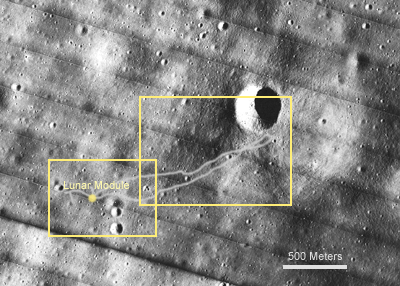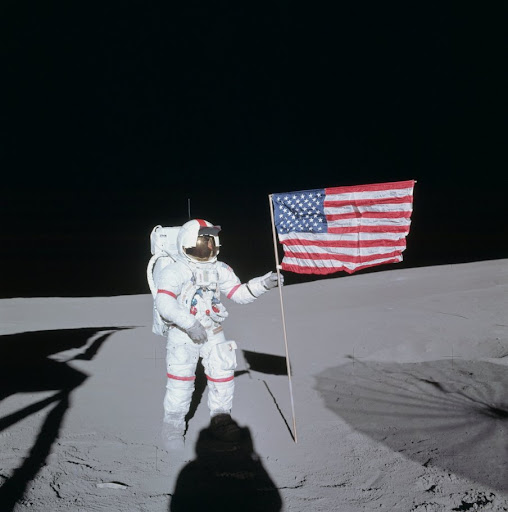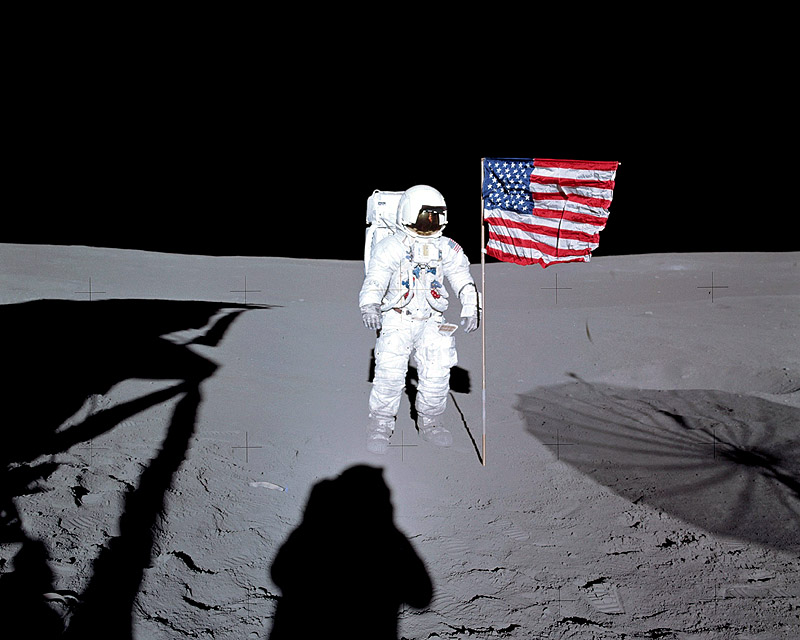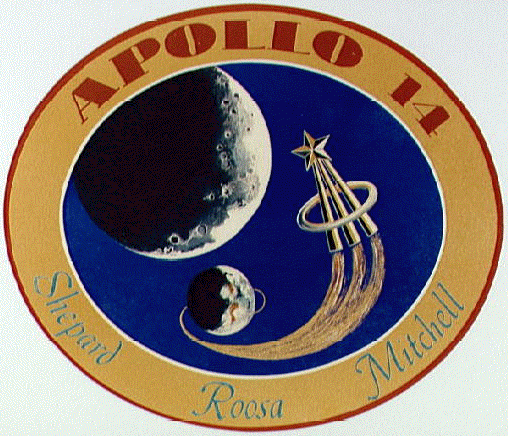
Posted on 01/25/2011 12:35:40 PM PST by chimera
After the near-disaster of Apollo 13 some ten months earlier, NASA and the Apollo program badly needed a successful mission. Apollo 14 delivered this more than adequately, although at times it was a close call.
The landing site for this mission was the Fra Mauro Formation at the edge of the Imbrium Basin, re-targeted from the ill-fated Apollo 13 flight. Apollo 14 is significant as the first lunar mission to make landfall in a region other than the flat mare topography of the earlier landings. It features a hilly, hummocky, ridge-like topography, and was thought likely to contain ejecta from the brightly-rayed Copernicus crater, over 360 kilometers north of the landing site. Quite near to the landing site is the very blocky Cone Crater, which was a prominent target for one of the two planned moonwalks. Here is a photo of the landing site taken by the Lunar Orbiter 3, showing an overlay of the eventual landing point of the lunar module and the EVA traverses:

Cone Crater is to the right of center. Note the somewhat rough terrain and the obvious light and dark patterns of the regolith, which indicates the varying texture of the material covering the surface.
Apollo 14 was the last of the scheduled “H” missions, which featured two EVAs, up to two days on the lunar surface, and precision landings close to specified targets. The original block of H missions included Apollos 12, 13, and 14. There was an added emphasis on science for these missions, as evidenced by the inclusion of the Modularized Equipment Transporter (MET) on Apollo 14. It was a hand-pulled two-wheeled cart used to carry geology tools, cameras, portable magnetometer, and boxes for lunar samples.
The launch date was January 31, 1971, with the ever-reliable Saturn V leaving the launch pad at 4:03 pm EST. It was the heaviest Saturn V launched to date because of changes made in the aftermath of the Apollo 13 mission. Most significantly, these included a third oxygen tank with separate, physically separated piping in the Service Module, to add an extra layer of redundancy and potentially avoiding the common-mode failure experienced on Apollo 13. The third oxygen tank had been planned for the extended-duration J-series missions that commenced with Apollo 15, but was moved up to Apollo 14 as an added safety feature. An auxiliary battery was also added to supplement electrical capacity.
Ascent to orbit was normal after a hold of about 40 minutes because of rain showers in the area and the possibility of lightning. After the heart-stopping launch of Apollo 12 in a rainstorm back in November of 1969, the launch directors at KSC were understandably skittish about trying another launch under those conditions.
Apollo 14 was plagued by a series of glitches, all of which were potentially mission-threatening. The first occurred during the transposition and docking maneuver shortly after translunar injection. For reasons never fully understood, docking of the Command Module Kitty Hawk with the Lunar Module Antares was unsuccessful after five attempts. Command Module Pilot Stuart Roosa was able to achieve a successful docking on the sixth attempt by approaching at a higher closure rate, with Mission Commander Alan Shepard manually operating the docking retraction system while the spacecraft were in contact. Time was running out as the spent Saturn IV-B stage carrying the lunar module was scheduled to begin dumping fuel and altering its course for impact with the lunar surface a short time after docking was finally achieved.
The next glitch occurred during the lunar landing phase. Commander Shepard and Lunar Module Pilot Edgar Mitchell had successfully undocked and were running through a planned simulation of the landing operation, which had been added for this mission in preparation for the landing in rougher terrain than Apollos 11 and 12 had encountered. In hindsight, it was provident that this simulation was added, as it uncovered a devastating problem: the LM abort system was being inadvertently triggered during the descent burn. The crew, working with ground controllers, theorized that a loose particle of solder may have been closing the manual abort switch. Mitchell was able to reset the errant signal by tapping the switch, but it would randomly close again. A software patch was devised to have the LM primary guidance system essentially ignore the abort switch during the landing phase. This was not a danger to the crew as an abort, if required, could still have been initiated using the LM abort guidance system, after which the primary guidance system could be enabled by keypad entry. However, the software patch would have an unintended consequence leading to the next, perhaps most heart-stopping glitch.
As the LM descended through 30,000 feet, LM Pilot Mitchell noticed that the landing radar had not “locked on” to the lunar surface as it was supposed to do at this point in the process. This continued and the LM approached the mandatory abort altitude of 10,000 feet, when, because of the lack of radar data, mission rules dictated that the landing attempt be waved off. Ground controllers suggested that the landing radar power circuit breaker be “cycled” (turned off and on, a familiar procedure to almost everyone who uses a computer and has had an annoying “lock-up”). Commander Shepard performed the operation and shortly thereafter landing radar data was acquired, allowing the mission to continue. It was later determined that this glitch was a consequence of the earlier software patch. The LM landing radar has two operating modes, long-range for higher altitudes and short range for operations close to the lunar surface. The software changes made prior to initiation of the descent burn inadvertently switched the landing radar into its short-range mode, and was therefore unable to obtain a valid reflection pulse from the surface at higher altitudes. Resetting the circuit breaker allowed the radar system to re-boot into its default state, which was the long-range mode. This essentially saved the mission.
Taken together, it is difficult to imagine the mission succeeding in the face of these problems without the manned presence. The capability to diagnose problems and take appropriate actions in real time requires human intervention that would have been difficult or impossible with exclusively automated systems. That is not to detract from the accomplishments of controllers of unmanned spacecraft because many of their mission “saves” have been truly remarkable, but in this case having astronauts on the spot was certainly an advantage.
Lunar module Antares landed on the moon on February 5th, 1971, only 174 feet from the pre-planned landing point. This was the closest landing to the designated spot of any of the Apollo missions. The LM came to rest at about an eight-degree angle relative to the vertical, which while not affecting the safety of the crew, plagued them with discomfort for the duration of their stay on the surface, making sleeping in the cramped LM quarters more difficult than usual.
Later that day, Alan Shepard became the only astronaut of the original Mercury astronauts to touch the lunar surface. At age 47, he was by far the oldest of all the men to walk upon the lunar soil. CAPCOM Bruce McCandless made note of this in a lighthearted manner as he observed Shepard descending the LM ladder on the TV monitor at Mission Control: “We can see you coming down the ladder right now. It looks like you’re about on the bottom step. [pause] And on the surface. Not bad for an old man.” Commander Shepard acknowledged the teasing in a similarly good-natured manner: “Okay, you’re right. Al is on the surface. And it’s been a long way, but we’re here.” Indeed, he was. Here is the famous picture of Alan Shepard at Fra Mauro on that historic day, taken by Edgar Mitchell after he had joined Shepard on the surface:

Notice that Shepard’s EVA suit has the red stripes denoting the mission commander, which made it easier to identify who was who in pictures and TV broadcasts. Shepard returned the favor for Mitchell in this photograph:

I always feel a tug at my heart and a sense of awe and wonderment to see the good old US flag and the human presence on the desolate but hauntingly beautiful lunar surface.
During their two moonwalks, the lunar explorers conducted a variety of scientific experiments, including the first use of a portable magnetometer to measure the strength of the lunar magnetic field, soil mechanics studies (in preparation for the use of the lunar rover in later missions), and the first-ever active seismic experiment conducted on the lunar surface. The active seismic experiment involved the use of a network of geophones, and a series of small explosive charges, affectionately called a “thumper”. The results allowed measurement of the detailed structure of the upper kilometer of lunar crust.
The biggest disappointment for Shepard and Mitchell was that they were unable to reach the crest of Cone Crater, which had been a prime objective for the geology studies. The rolling lunar terrain was simply too confusing and difficult to navigate with any certainty. Hauling their MET through the fine lunar soil on the long slog up the slope of Cone Crater caused the two men to seriously deplete their oxygen supply. Ground controllers finally called it quits before the astronauts could reach the rim. Later it was determined that they came within 65 feet of the crater rim. Photographs from the Lunar Reconnaissance Orbiter clearly show the Antares descent stage, the ALSEP instruments, and the tracks for Shepard, Mitchell, and the MET (arrows point to them on the picture below, where they look like dark streaks):

In spite of not reaching the crater rim, the samples retrieved by the Apollo 14 crew yielded a rich geologic harvest. As expected, most of the rock samples were breccias, which are rocks that are an amalgamation of other materials fused by the heat and pressure of meteoric impacts. These rocks obviously have a complex history, with the fragments of breccias often being breccias themselves. The Apollo 14 breccias showed a history of multiple generations of impacts. This confirmed that the landing site, as well as likely the entire Fra Mauro region, was formed by impact basin debris. About 42 kilograms of lunar samples, the most ever retrieved to that date, were returned for analysis.
The most whimsical moment of the Apollo 14 mission occurred just prior to the closeout of EVA 2 activities. Mission Commander Shepard surprised viewers on Earth by unveiling a makeshift six-iron golf club, formed from the contingency sampler handle and a regulation 6-iron head. Shepard carried two golf balls in his EVA suit pouch. The first ball was dropped to the surface and Shepard attempted what he aptly called a “sand shot”. The bulky, stiff pressure suit obliged Shepard to try a one-handed swing. He duffed the first shot, dropped a second ball for the first “mulligan” on the moon, and tried again. This second attempt also was scuffed to the side a few feet. Retrieving it, the undaunted Shepard, an avid golfer back on earth, finally connected with a solid shot, that he described as travelling “straight as a die, miles and miles and miles”. It was later estimated that Shepard’s mid-iron shot likely carried anywhere from 200 to 400 yards. Quite respectable for a six-iron out of the sand, using one hand.
Not to be outdone, Mitchell got in on the lunar athletics by trying his own “Javelin Throw”. After stowing the Solar Wind Experiment (SWE), and perhaps inspired by Shepard’s athletic prowess, Mitchell fashioned his “javelin” from the SWE support pole, or “staff”. A natural lefty, Mitchell uncorked a javelin toss that sailed somewhere around 200 yards from the LM landing site.
Antares left the lunar surface on February 6, with the mission concluding with splashdown on February 9th. The mission was not troubled by any further glitches. All mission objectives were achieved. In many ways, the complete success of Apollo 14 got the program back on track and paved the way for the spectacular triumphs of the final three missions.
The crew of Apollo 14 was an interesting blend of old and young. Mission Commander Alan Bartlett Shepard Jr. was in some ways the “Comeback Kid” of the space program, in spite of his “senior citizen” status. He was of course already famous as America’s first man in space, flying the 15-minute suborbital hop on the Mercury-Redstone 1 flight in the spacecraft appropriately dubbed “Freedom 7”. Shepard was grounded from spaceflight after being diagnosed with Meniere’s Disease, which affected his vision, balance, and hearing. Wanting to stay in the space program, Shepard accepted assignment as Chief of the Astronaut Office. Following successful surgery for treatment of his malady, Shepard was restored to flight status in 1969. He lobbied for command of Apollo 13, but was bumped to Apollo 14 (fortunately for him, as it turned out) when NASA management felt he needed more training time after returning to flight status. A native of Derry, New Hampshire, Alan Shepard was an Annapolis graduate and WWII veteran. After the war, he entered flight training and became a naval aviator. Shepard was one of the very best Navy test pilots, which led to his selection as one of the Original 7 Mercury astronauts. Out of 110 applicants for astronaut training, Shepard proved his mettle and was selected to make the very first American spaceflight, which he did on May 5th, 1961. Shepard retired from the NASA and the Navy, attaining the rank of Rear Admiral. He entered private business and served on many corporate boards. His business investments made him a millionaire while still in the astronaut program. Adm. Shepard served as President of the Mercury Seven Foundation, a charitable non-profit organization which provides scholarships for deserving students of the sciences. Alan Shepard died of leukemia in Pebble Beach, CA, on July 21st, 1998, which, fittingly, was the 29th anniversary of the Apollo 11 moonwalk. An interesting trivia item is that Alan Shepard can trace his ancestry back to the Mayflower, so it is a case of going from the Mayflower to the moon, one family exploring two “New Worlds”.
Command Module Pilot Stuart Allen Roosa was a native of Durango, CO. He was a Colonel in the Air Force, serving from 1953 to 1976. Roosa was an experimental aircraft test pilot at Edwards AFB and joined NASA with the group of 19 astronauts selected in 1966. His skill as a Command Module pilot impressed Alan Shapard and he requested that Roosa be assigned to his crew. The Apollo 14 mission featured the first use of shortened lunar rendezvous techniques and Roosa was able to perform these maneuvers without incident. He also carried out extensive scientific observations from lunar orbit during his solo piloting of the spacecraft while his cremates were at the Fra Mauro landing site. After retiring from NASA and the Air Force in 1976, Stu Roosa worked in commericail real estate development, and in March of 1981 gained perhaps the most interesting post-flight career of a NASA astronaut when he became owner of Gulf Coast Coors, Inc., in Gulfport, MS. Stu Roosa passed away on December 12, 1994, from complications of pancreatitis.
Lunar Module Pilot Edgar (Ed) Dean Mitchell might rightly lay claim to the title of First Scientist on the Moon, since he holds a D.Sc. in astronautics from MIT, although Harrison “Jack” Schmitt of Apollo 17, as a geologist, is often accorded that honor. He was born in Hereford, TX and grew up in New Mexico. Mitchell was acknowledged by his fellow astronauts as the undisputed expert in LM systems, which certainly came in handy on the Apollo 14 mission. As recognition of his intellectual prowess, Mitchell earned the nickname “The Brain” from his colleagues, even before “Pinky and the Brain” came to be. After graduating college in 1952, Mitchell enlisted in the US Navy and was selected for OCS. He completed flight training and became a naval aviator, doing foreign duty in Okinawa and later serving on carriers. Mitchell became a Navy test pilot and instructor. He joined NASA in 1966 and served as backup LMP on Apollo 9. He attained the rank of Navy Captain when he flew the Apollo 14 mission in 1971. Mitchell completed his last NASA assignment as backup LMP for Apollo 16, and retired from NASA and the Navy in 1972. Dr. Mitchell started a somewhat unusual career after leaving NASA when he founded the Institute for Noetic Sciences in 1973, a foundation organized to study aspects of the nature of human consciousness. Mitchell had long been interested in this subject and came in for some criticism and teasing for conducting ESP experiments while in space on Apollo 14. Today Ed Mitchell stays active delivering numerous lectures and seminars on topics such as cosmology, human potential, and the future of the human species on Earth. He is also a consultant to a limited number of corporations and foundations. Ed Mitchell lives in Palm Beach, FL, is the father of six children, and has nine grandchildren.
While Apollo 14 might not be the best-known lunar mission, it opened the door to the first truly scientific explorations of another world. For this reason, we should remember it and those who braved the unknown to make it a reality.


Thank you.
LOL ... that’s a heck of a divot!
|
· join list or digest · view topics · view or post blog · bookmark · post a topic · subscribe · |
|||
Antiquity Journal & archive Archaeologica Archaeology Archaeology Channel BAR Bronze Age Forum Discover Dogpile Eurekalert LiveScience Mirabilis.ca Nat Geographic PhysOrg Science Daily Science News Texas AM Yahoo Excerpt, or Link only? |
|
||
|
· Science topic · science keyword · Books/Literature topic · pages keyword · |
|||
Antares left the lunar surface on February 6, with the mission concluding with splashdown on February 9th.Thanks chimera.
 |
||
| · join · view topics · view or post blog · bookmark · post new topic · subscribe · | ||
| Google news searches: exoplanet · exosolar · extrasolar · | ||

..”Miles, and miles ..and miles” = SHEPPARD’s approach shot..
You might find this interesting:
Applause!
Great story of the Apollo 14 mission and those very brave American explorers.
Thanks for the heads up on this.
Disclaimer: Opinions posted on Free Republic are those of the individual posters and do not necessarily represent the opinion of Free Republic or its management. All materials posted herein are protected by copyright law and the exemption for fair use of copyrighted works.